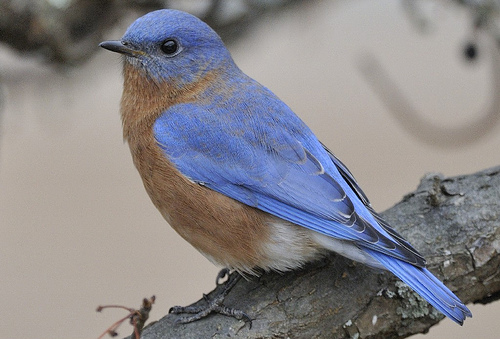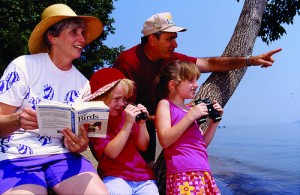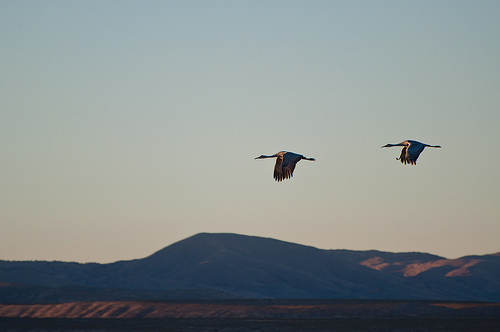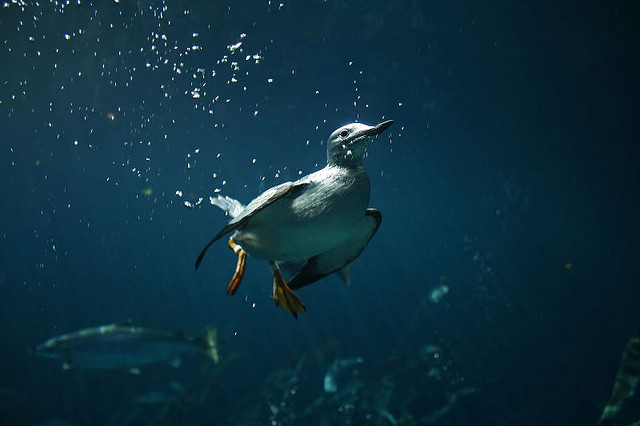New birder Lori had no idea the spark was in fact a spark:
It was January 28, 2010, and I was driving down Route 27 toward Wayland on my way to work. As I crossed the Sudbury River, something at the top of a tree lining the road caught my attention, enough so that I safely turned around in the Wayland Golf parking lot and crept up the street as slowly as commuter traffic would allow (which is to say, not slowly at all!). There, at the top of the tree, sat a Bald Eagle, though at first I was not at all convinced it could be possible. An eagle? In Sudbury? I called my husband (a closet birder for many years) and described what I was seeing and he said, “Oh yes, that is absolutely an eagle!” I had only ever seen an eagle once before, at Foxboro Stadium, when an eagle flew down and landed on the shoulders of its trainer as part of a pre-Patriots playoff game extravaganza. To me, that didn’t count as seeing a bird – but THIS surely did!
Still not truly bitten by the birding bug, two months later we traveled to Charleston, South Carolina, for a few days in early April. It was there, in the middle of the Magnolia Cemetery, that I saw my first Eastern Bluebird. He was sitting stoically atop a bronze Confederate soldier statue. It was this bluebird, coupled with the eagle, that hooked me – to know that these wonderful birds, which I’d always considered elusive, could be found in every day places when you least expected to find them was a thrill I cannot adequately put into words.
Lori’s spark bird #2 was an Eastern Bluebird. photo by USFWSNE
Since then I have been blessed to see many cool birds, such as the Pink-Footed Goose that visited Sudbury in November 2010, and I’ve learned that the best place to bird is actually my backyard – a very unique spot that to date has brought me 105 different species of birds – 100 of which I have seen this year alone, including #100 a few weeks ago, a life bird – the Evening Grosbeak. For my birthday this past October, my husband bought me a 14′ tall “hunters chair” which sits on a metal tripod in my backyard. The chair rotates 360 degrees, and when I am sitting way up there the view of my yard, and the woods surrounding it, is fantastic. I can only imagine the fun I will have next April when spring migration slowly begins to set in.
I do at times lament the wasted opportunities at birder’s paradises – trips I took long before I was interested in birds – Bermuda, Sanibel, the Pacific Coast, Maui, the Caribbean – but for now I am pretty happy to find so much to enjoy so close to home.
I’ve made a few missteps along the way (i.e. the Northern Lapwing I was sure I saw in Lincoln that turned out to be an escaped Red-Whiskered Bulbul – sorry about that, everyone….). But I have learned so much from all of you, and I am paying it forward by now teaching my 6-year-old Godson to recognize the birds in his neighborhood along the shores of Lake Quannapowitt in Wakefield.
Jo-Dee grew into birding through a series of spark events:
I grew up in a house on the side of a wooded hill in Fitchburg, MA. Like another of the stories, periodically a cock pheasant would stroll across the hill. There were always shouts of “Look outside!” My parents weren’t birders, but my father, particularly, was very interested in the natural world. I had a Golden Book bird guide. Periodically he would describe a bird that he had seen and would ask me if I could find it in the book.
Time flies and when you’re a teenager, interests shift and no one that I knew was really into “nature.” Turns out in college, my knowledge of pheasants would come in handy. For my phys ed requirement, I took riding. The fields in South Hadley had pheasants. I probably saved a couple of my colleagues from untimely “departures” as I could identify the call of the pheasant and would call out “Pheasants in the field” if I heard them so that we could all take a little tighter rein of out steeds just in case we flushed them.
Several non-birding years later, my husband and I moved to the edge of the Charles River in Watertown. Our corgi, Bennie, and I would stroll through the park on the edge of the river by the Perkins School. That first spring the warblers arrived… there were all these amazing birds in the trees and the need to identify them took over.
Then I discovered that my best childhood friend, now living in Tuscon, Arizona, had become a birder…. and then my sister-in-law… companions with the same interests turn birding into fun…. and a bit of a competition.
Then there was the day in Madera Canyon. I had made a deal with my then 2nd grade daughter Emily that if we could bird for the morning we would stop at the Pima County Fair on the way back to my friend’s house. Birders were moving up and down the canyon in search of the trogon we could all hear. Emily ran down the trail – froze – and found herself face-to-face with a pair of trogons. She was hooked.
About 4 years later, we were back in Arizona for school break and Nathaniel, then a 2nd grader himself, found a Hermit Warbler along the edge of Sonoita Creek. He was immensely proud that he identified it all by himself. Another one hooked! School vacations then became birding adventures. Nothing better than birding with your kids. They have sharp eyes and good ears!
My son is about to move to Ann Arbor….. I’ve promised to come visit him in the spring …. there are Kirtland’s warblers out there (a major blank in my life list). He’s promised to go birding with me.
Amy describes her exposure to birding as a youngster and a rekindling after college:
When I was 9 years old my father gave me a Peterson field guide. My parents then decided they would take me to New Mexico to see museums and parks, including Bosque del Apache National Wildlife Refuge south of Albuquerque. On the plane ride down, I studied the field guide and as a young artist I even sketched some of the birds, too.
I remember learning that the Whooping Crane was endangered and was rare to see, but we saw it! We also saw many Sandhill Cranes.
Seeing Sandhill Cranes at the Bosque del Apache National Wildlife Refuge was an early spark for Amy. photo by jronaldee
I remember seeing a small light-colored bird on a fence that sparked my memory of what I had read on the plane ride down. I said to Dad, “I think it’s a Say’s Phoebe”. He looked at me, doubtful that a nine-year-old that who just been introduced to serious birding would be able to identify a bird that we’ve never seen before. In the end, (and I surprised myself too) I was right. And since my parents gave me encouragement and praise, I will never forget that triumphant moment! I loved being right about birds!
Growing up, my father and I listened to Eastern bird sounds on tape and laughed when the narrator sounded funny as he tried to sing out the name-sayers and mnemonic phrases. We remembered, or tried to at least, all of them and often quizzed each other. We even watched Sir David Attenborough’s “The Life of Birds” over and over again. Oh, do I wish to see the birds of paradise someday!
Like another one of the stories I read on this thread, I stopped birding for a while. Unfortunately, I let my high-school worry about appearance and popularity get the better of me. I still loved it, but I refused to show it. I slowly got back into it at the end of my college years and I found myself excited to introduce it to my friends.
Today, my Dad and I are closer than ever and we try to bird together whenever we can. I’ve also introduced my fiance to birding and something has sparked his interest because he kept begging me to go down to see the Lapwing and now we may take a trip north to find a Northern Hawk Owl. I am 28 years old and looking forward to many more birding adventures!
Greg’s spark occurred nearly four decades ago and he is nearing the coveted 700 mark on his ABA life list:
My spark was a beautiful Rose-breasted Grosbeak, seen with my father in the spring of 1974. Today, I found out I likely have lyme disease; the symptons brought me home early from a work trip to San Francisco. My doctor’s office is in Hyannis – 2 minutes from Kalmus Beach, so before I went in I was “lucky” enough to find the Little Egret and a bonus Black-headed Gull (around 10 AM this morning). The Egret was #699 in my ABA list, putting the pressure on to find another lifer before crossing 700 on a technicality. Thinking about that, I decided that I’d celebrate again in the future if I cross 700 based on the 1974 taxonomy.
Mark has a different story from most birders:
For many years I’ve been a fish geek. I grew up on Jacques Cousteau TV specials, got very into aquariums, and eventually became a scuba diver to see the reefs for myself. As an amateur marine biologist, I learned the common names of all of the reef fishes, and eventually most of the Latin names as well. I studied their behavior and interactions. I learned not just the flashy colorful fishes, but how to tell the silvery ones apart, and how to see the well-camouflaged ones as well. It was disappointing that I could only afford a couple weeks a year in the tropics, and while there a dive only lasts an hour at a time.
At some point I noticed that often while out on dive boats, some of the other divers would be commenting on the various sea birds around us. I used to hassle them that “they all looked like sea gulls to me” when they said one was a booby and another a shearwater. During a dive trip in the Sea of Cortez when there were Peregrine Falcons on the cliffs above our dive sites, I discovered that birds could be interesting (it’s taken me a while to warm to sea birds which still all look a lot alike to me). Once I started paying attention to the birds back home in Boston, I realized that birdwatching used many of the same skills as fish watching, and I could do it year round. I’ve been hooked ever since. After a couple of years of watching them, I discovered I could listen to many more than I can see.
You can’t really understand the feeding habits of boobies, cormorants, or penguins until you’ve dived with them and seen them underwater. Here is a Common Murre at Montreal’s Biodome. photo by christopher.woo
I still plan my travels around diving, but always bring my binoculars too. Twice I’ve actually gotten lifers *during* a dive. Coming up during a dive in Monterrey Bay in California to get my bearings back to the beach where we entered, I saw my first Black Turnstone on some nearby rocks. And in Fiji I surfaced near a navigation buoy where my first Nazca Booby was perched. You can’t really understand the feeding habits of boobies, cormorants, or penguins until you’ve dived with them and seen them underwater. It’s pretty startling to be 20 feet underwater when a booby makes a plunge dive right in front of you.
My next dive trip is in the Bahamas, and I expect to see our warblers wintering there, when I’m not underwater.





Pingback: What Sparked My Interest in Birding – Part 14
Pingback: A Wrap-up To The “What Sparked My Interest?” Posts